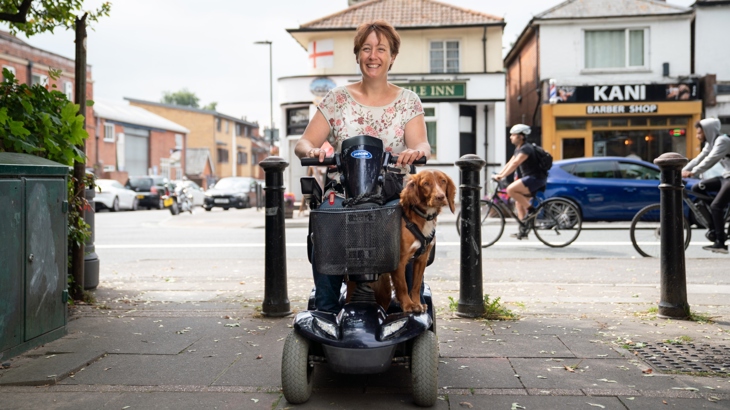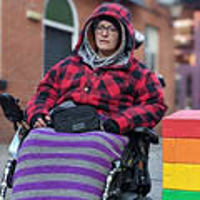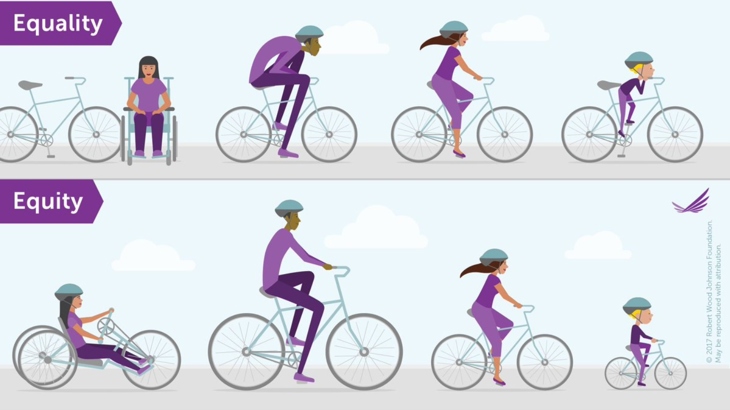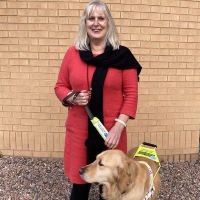Senior Policy Officer Alice Clermont discusses the experiences of disabled women when getting around our local areas. She explains why the combination of disability and gender makes barriers to walking and wheeling even greater for disabled women, as revealed in the recently published Disabled Citizens’ Inquiry. Using practical recommendations, she explores how making our streets more inclusive can lead to equity for everyone.

Disabled women are doubly disadvantaged when it comes to moving around our local areas. Credit: Joe Hudson
Greater barriers to walking and wheeling for disabled women
From getting a loaf of bread to meeting up with friends, disabled women’s daily activities look like everyone else’s.
And yet, they face greater barriers to walking and wheeling which can make local journeys much harder or even impossible.
Nearly half (45%) of disabled women often experience problems reaching their destination due to accessibility, significantly more than disabled men (35%).
Due to the gendered division of caring responsibilities, women are more likely than men to travel with a pram, children or older people.
Disabled women are not immune to this unequal split of unpaid care.
When taking children to school or accompanying older relatives to destinations, disabled women often face additional barriers and existing issues may be worsened.
Similarly, significantly more disabled women (37%) than disabled men (28%) are afraid of negative comments from other people due to a physical or mental health condition.
Evidence shows disabled women are more likely to experience street harassment, which can compound fear of negative comments.

Dennis, Greater Manchester
I’m a mum to three children. From a young age, I had to teach my children to walk alongside me on the pavement, whilst I travelled parallel on the road in my wheelchair.
The pavements are too narrow and inaccessible for both me and my children to use side-by-side, often because of vehicles parked on pavements.
This was therefore the safest way to take my kids to school or the shops when they were younger.
Cost-of-living crisis hitting disabled women harder
Whilst the rising cost of living is negatively impacting many disabled people, disabled women are often worse hit by increasing costs.
They are significantly less likely to be employed and more likely to be economically inactive than disabled men and non-disabled people.
Those who are in work are doubly disadvantaged by the gender pay gap and the disability pay gap.
Recent analysis shows that disabled women face the biggest pay gap and are paid on average 35% less than non-disabled men.
The cost-of-living crisis is also having a direct effect on disabled women’s travel habits, with 62% saying they have had to reduce the amount they travel.
Our research shows that, along with disabled women, disabled people on low incomes and disabled people of colour are disproportionately impacted by physical, cultural and financial barriers.
For disabled women of women and/or on low incomes, these barriers can become even more compounded.

Alisha, Greater Manchester
I find the tram easy to use as it’s very regimented and the stops are called out.
However, I can’t feasibly walk to my nearest tram stop as I live too far away, so if I want to get the tram, I have to get a taxi.
This adds on a lot of cost when I want to go out and makes it really hard for me to access going outside.
It’s worrying when I think about how I’m going to get to medical appointments or go food shopping when I’m having to put aside a large amount of my monthly income for public transport which isn’t even accessible for me.
Embracing equity for disabled women
The theme for this year’s International Women’s Day is #EmbraceEquity. Why ‘equity’ and not ‘equality’?
Equality means giving everyone the same resources or opportunities, regardless of their situation or requirements.
Equity recognises that each person has different circumstances and offers tailored resources and opportunities to reach an equal outcome.
In order to embrace equity for disabled women, we need to acknowledge the greater barriers faced by disabled women and put practical solutions into place to address them.

The difference between working towards equality and equity. Credit: Robert Wood Johnson Foundation
Supporting disabled women to walk and wheel more
We’ve seen that disabled women are less likely to find walking and wheeling accessible, inclusive and enjoyable.
Through the Disabled Citizens’ Inquiry, disabled women identified the key recommendations that would particularly help them to walk and wheel more:
Involve disabled people in decision making
- 83% of disabled women would find dedicated disabled people’s walking and wheeling panels helpful to walk or wheel (compared to 74% of disabled men).
Stop pavement parking and manage pavement clutter
- 77% of disabled women say that a ban on pavement parking would help them to walk or wheel more (compared to 67% of disabled men).
Create long-term funding to improve and maintain pavements
- 82% of disabled women said that a dedicated pavement fund would help them walk or wheel more (compared to 74% of disabled men).
Ensure disabled people can live within walking or wheeling distance of services
- 89% of disabled women think a planning system which ensures more essential services are provided within walking or wheeling distance of where people live would help them walk or wheel more (compared to 85% of disabled men).

June, County Down
The minute I go through my front door, my adventure starts. I always hope it will be a good adventure.
One of my biggest challenges is vehicles parking on the pavement, particularly near junctions. When my guide dog Clyde takes me out round a parked car, I can’t tell if it’s just one car, or a whole line of them. I often have to orientate myself back and start all over again, or just return home.
My solution would be a complete ban on pavement parking.
Listening to disabled women
To address the greater barriers faced by disabled women, transport professionals, town planners, urban designers and local authority decision-makers need to first recognise them.
Taking an equity approach can help us to understand how barriers can be compounded.
Listening to disabled women and putting lived experience at the heart of decision-making can then help us make our neighbourhoods more inclusive – for disabled women and, indeed, for everyone.
Read more about the Disabled Citizens' Inquiry and how we're giving disabled people a voice.
Are we doing enough to ensure equity, inclusion and social justice in walking and cycling?
Find out why cities that are designed for women are better for everyone.





